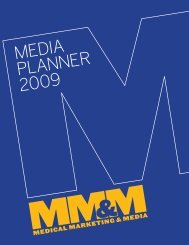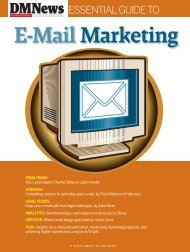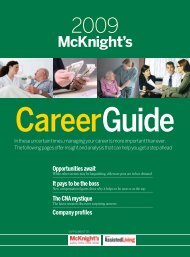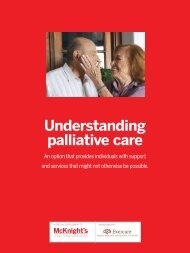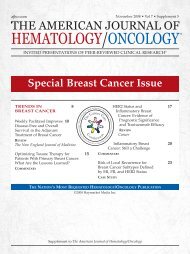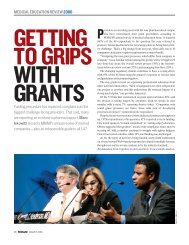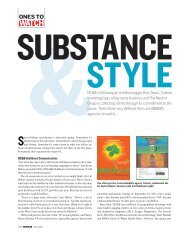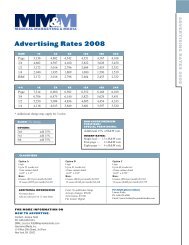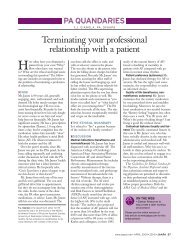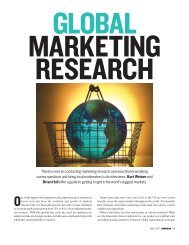(l-r) Alan Breier, MD, Chief Medical Officer, Mike - Haymarket
(l-r) Alan Breier, MD, Chief Medical Officer, Mike - Haymarket
(l-r) Alan Breier, MD, Chief Medical Officer, Mike - Haymarket
You also want an ePaper? Increase the reach of your titles
YUMPU automatically turns print PDFs into web optimized ePapers that Google loves.
(l-r) <strong>Alan</strong> <strong>Breier</strong>, <strong>MD</strong>, chief medical<br />
officer, <strong>Mike</strong> Bigelow, assistant<br />
general counsel, and David Garza,<br />
manager of medical education
PHOTO LEFT: GREG PEREZ, TWIIN PHOTOGRAPHY<br />
For Eli Lilly, innovation is in the blood. In 2004 the Indianapolis<br />
firm, the 10th largest pharmaceutical company by US<br />
sales, decided to act on what is now a natural instinct<br />
among life science companies: posting clinical trial data on<br />
the Internet. Its industry-first spawned a trend throughout<br />
pharma and biotech.<br />
“In a very short period of time, we went from not having<br />
clinical trials and clinical trial results in the public domain to<br />
being besieged, and it hit me at one point that this is now the<br />
norm,” says <strong>Alan</strong> <strong>Breier</strong>, <strong>MD</strong>, Lilly’s VP, medical, and chief<br />
medical officer.<br />
Lilly would like to spark a similar trend with its CME registry,<br />
which appeared May 1 and opened the files on $11.8 million worth of<br />
grants given to 495 organizations during the first three months of the<br />
year. The firm pledged to update data on a quarterly basis. “It seemed<br />
like the same sort of sea change was possible [in CME],”says <strong>Breier</strong>.<br />
Indeed, this may be a watershed moment. Pfizer executives hope to<br />
incorporate disclosures for 2008 education grants, pending approval<br />
from senior management, and CME execs from Wyeth, Novartis and<br />
Shire say they plan to go public, too, along with some grant recipients<br />
such as patient and physician groups.<br />
Lilly and others say openness is needed to counter misperceptions<br />
that CME funding is a tool for promotion. Ever since PhRMA, the trade<br />
group, discussed industry funding of CME in its 2002 code, followed a<br />
Eli Lilly’s CME grants registry shows Massachusetts General Hospital’s<br />
psychiatry department received the largest single grant, $825,000 for<br />
a year-long educational program with some 150,000 registrants.<br />
year later by the Office of Inspector General’s compliance guidance,<br />
which outlines the government’s expectations around commercial support<br />
for education, the media have ratcheted up criticism of CME. A<br />
number of high-profile marketing scandals provided grist for the mill. It<br />
all culminated in a Senate Finance Committee inquiry, which ended in<br />
April, and a Senate Special Committee on Aging hearing in late June.<br />
In CME, the drug industry has another opportunity to bolster its<br />
MEDICAL EDUCATION REPORT<br />
CME’S OPEN<br />
GESTURE<br />
This year, to counter public skepticism, Eli Lilly revealed its educational<br />
grants in an online database. Now the transparency wave may be gathering<br />
steam, with other pharmaceutical firms, as well as patient groups and<br />
societies, saying they may make grants public, too. Will the efforts help<br />
restore trust in CME? Marc Iskowitz reports<br />
AUGUST 2007 MM&M 37
Grant disclosure: Phenom or fad?<br />
Eli Lilly is hoping its decision to launch an online CME grants registry at<br />
www.lillygrantoffice.com sparks a trend within Big Pharma. Here’s a<br />
look at other organizations considering CME disclosure.<br />
Pfizer’s Cathryn Clary, <strong>MD</strong>, MBA,<br />
SVP, US <strong>Medical</strong><br />
“I really applaud Eli Lilly for [disclosing grants]. Pfizer is<br />
considering a similar type of transparency. We’re<br />
actually looking a little bit broader than CME. In the last<br />
six months, we put our pipeline out on the Web…We<br />
put access to our post-marketing commitments<br />
[online]…Clinical trials disclosure is another thing…Everything that we<br />
do is going to wind up being very open and transparent to the public.<br />
Pharmaceutical companies right now are very, very interested in being<br />
as open and as transparent as we can be, because we feel we actually<br />
flagging trust levels. “All of the noise around this was so negative, and<br />
yet a lot of good from the funding that we provide to these groups—<br />
there was a real disconnect there,” says <strong>Mike</strong> Bigelow, Lilly assistant<br />
general counsel. “We were, frankly, just looking for a way to get out<br />
ahead of the issue a little bit.”<br />
“If providers are concerned about<br />
information being public, that’s a<br />
good litmus test of the strength<br />
and validity of their programs”<br />
—Steven Singer, PhD, PeerPoint<br />
With just over a billion dollars invested in 2005, according to figures<br />
from the Accreditation Council for CME (ACCME), CME is not drawing<br />
as much as some of the industry’s other disciplines. The level of controversy<br />
surrounding CME, though, belies its size. Journalists, bloggers,<br />
academics and lawmakers have criticized it as a covert method for<br />
influencing prescribing, and that is the great question roiling the profession<br />
today.<br />
A hot potato<br />
Does transparency really help counter that notion? Providers<br />
were mostly of the same mind on the issue.<br />
What Lilly is doing resolves the issue, but its action means that the<br />
spotlight is on providers now, asserts Steven Singer, PhD, director, education<br />
services, PeerPoint <strong>Medical</strong> Education Institute. “They’re forcing<br />
transparency, passing the hot potato to the provider. If providers<br />
are concerned about that information being public, then that’s a good<br />
litmus test for the strength and validity of their medical education programs<br />
relative to improving patient care.”<br />
Pri-Med, the Boston-based medical education and communications<br />
company (MECC), secured a total of $976,285 for several activities on<br />
erectile dysfunction, depression and pain and diabetes, according to the<br />
MEDICAL EDUCATION REPORT<br />
have an excellent story to tell around drug safety, clinical trials and<br />
innovation. The same is going to apply to CME.”<br />
AstraZeneca’s Pamela Mason, director,<br />
<strong>Medical</strong> Education Grants<br />
“We place great value on individual integrity, ethical<br />
conduct and full compliance with the laws, regulations<br />
and guidelines that govern the US healthcare<br />
community, and we are looking across our business at<br />
ways in which we can be more transparent than we<br />
already are…We do not anticipate changing our approach to<br />
supporting [education] at this time. The idea of transparency meaning<br />
clearness and simplicity is an important one and may help to elevate<br />
the recognition of the value of CME and the value of the appropriate<br />
roles of providers and supporters with the end result of collaborating to<br />
improve patient care.”<br />
Lilly registry. An official says that more contextual information would<br />
have been useful to back the independence of each grant. The registry<br />
simply lists the grantee name, amount and a short description.<br />
“I think the intent was transparency from the financial perspective.<br />
That is good,” says Marissa Seligman, PharmD, Pri-Med Institute chief<br />
clinical and regulatory affairs officer, “but when disclosing CME support,<br />
it is almost [as] important to provide details beyond the finances,<br />
such as accredited provider, target audience, educational objectives<br />
and duration of the grant. It is important for the public to understand<br />
why the grant monies are being set forth, i.e., which educational gaps<br />
are they intended to support.”<br />
<strong>Breier</strong> counters that Lilly’s strong policies and procedures ensuring<br />
the independence of CME are sufficient to instill confidence. “We do<br />
not support educational activities [that promote] our products,”he says.<br />
“And [we] have all of the safeguards in place to ensure that that doesn’t<br />
happen. So by going public…hopefully we will be able to change some<br />
of those misperceptions.”<br />
Lilly has no role in influencing content or speakers, <strong>Breier</strong> adds.<br />
Decisions about which programs to fund are made by its medical officials,<br />
not its marketing department. Ninety percent of funding goes to<br />
accredited education. None of it is spent to promote the company’s<br />
products. “We’re on course this year [to provide] 3,000-4,000 grants<br />
that will total $50-$60 million,” Bigelow says. The company, like most<br />
grantors, focuses grant money in therapeutic areas of expertise. <strong>Breier</strong><br />
says Lilly is expecting its funding levels to remain constant this year, as<br />
they have for the last two.<br />
Lilly says providers support its decision. “Maybe at first, before they<br />
really understood the reasons behind [disclosure], there may have been<br />
some concern on their part, but I didn’t get that after I talked to them,”<br />
says David Garza, Lilly manager of medical education. “They were<br />
very much on board with our decision.”<br />
Senate report<br />
The Senate Finance Committee was impressed, too. Sens. Max<br />
Baucus (D-MT) and Charles Grassley (R-IA), the ranking mem-<br />
AUGUST 2007 MM&M 39
ers of the committee, said in a statement that they hope that<br />
other drug companies will take similar action.<br />
They were less sanguine, though, in their April report, concluding<br />
that pharmaceutical companies support CME activities as a way to<br />
broaden their markets. “Drug companies routinely fund educational<br />
grants to support programs that favorably discuss the companies’<br />
newer and more lucrative products,”the report stated. It had measured<br />
praise :“This report shows some separation between medical education<br />
and marketing efforts, but this process isn’t clean enough.”<br />
But the senators reserved their harshest criticism for CME oversight,<br />
which they found to be largely ineffectual: Educational grant programs<br />
are not pre-approved or directly monitored, and “oversight actions may<br />
occur long after the problematic educational activity occurred,” taking<br />
as long as nine years from the noncompliant activity for a provider to<br />
lose accreditation.<br />
Evaluating the stringency of rules was at the top of the ACCME’s<br />
agenda when its board met last month to discuss a response. The group<br />
may wind up tightening its accreditation process rather significantly.<br />
Murray Kopelow, <strong>MD</strong>, ACCME chief executive, told MM&M in May<br />
that considerations include placing monitors in audiences and toughening<br />
the Standards for Commercial Support: Standards to Ensure the<br />
Independence of CME Activities. (The meeting was set to convene<br />
after this article went to press.)<br />
In the months preceding the July meeting, ACCME requested comment<br />
from accredited providers on rules governing the relationship<br />
between providers and commercial interests, a move some say portends<br />
future refinements to the SCS.<br />
Another response ACCME is looking at is disclosure. “Trans-<br />
Five tips for disclosure*<br />
1Back up disclosure with compliance: Before increasing public<br />
access to your grant information, grantor and provider policies<br />
and procedures should be in place to ensure educational dollars are<br />
not being used for promotion.<br />
2Assure buy-in from executive management Eli Lilly VP,<br />
medical, and chief medical officer <strong>Alan</strong> <strong>Breier</strong>, <strong>MD</strong>, chaired the<br />
internal group responsible for Lilly’s online grant registry initiative<br />
3Put providers on notice Letters of agreement (LOAs) should put<br />
providers on notice by stating that grants they receive may be<br />
disclosed at some point.<br />
4Commit to regular updates Re-populate the database regularly<br />
and start with at least a full quarter of data. Consider providing<br />
details beyond finances, such as accredited provider, target<br />
audience, educational objectives and duration of grant—all of which<br />
help the public see why the grants are being provided.<br />
5Listen Collect feedback from providers at industry conferences<br />
as to whether they support your initiative, why or why not and how<br />
you can refine it.<br />
* For a grantor<br />
Source: MM&M reporting<br />
MEDICAL EDUCATION REPORT<br />
parency is always good,” said Kopelow. “People talk about sunlight<br />
being a good solution to a problem. ACCME will definitely consider<br />
making public [the] accreditation status and compliance findings of<br />
accredited providers to the extent this might be of value to the system.”<br />
The FDA’s general counsel, Sheldon Bradshaw, said his agency also<br />
may rethink its rules concerning companies involved in funding education—encapsulated<br />
in a set of 1997 guidelines. “Does the FDA…need<br />
to be more vigilant in these areas? Perhaps,” he said at a CME industry<br />
meeting in May. Whether its role will change significantly is less likely,<br />
though. Bradshaw said that while the FDA has an interest in making<br />
sure CME is not a shill for promotion, “This is a complicated area. The<br />
agency itself is walking a delicate line in making sure we’re protecting<br />
“ACCME will consider making<br />
public the accreditation status and<br />
compliance findings of accredited<br />
providers”<br />
—Murray Kopelow, <strong>MD</strong>, ACCME<br />
the First Amendment rights of [CME] providers.”<br />
However, the Senate seems to have left the door open for FDA<br />
involvement, and some expect it. “I see a resurgence of the role of FDA<br />
in terms of promotional education,” said Marty Cearnal, EVP, chief<br />
strategy officer, Jobson <strong>Medical</strong> Information. “With a new commissioner,<br />
FDA will take a stronger position there, like it did around<br />
DTC.”<br />
CME glasnost<br />
CME glasnost may not be a phenomenon yet, but at the very least, it’s<br />
triggering some extended conversations in med-ed circles (See sidebar,“Grant<br />
disclosure:Phenom or fad?”on p. 39). It began in 2006, as<br />
Lilly executives huddled to review the firm’s response to a second<br />
round of questioning from Sen. Grassley during the Senate’s twoyear<br />
inquiry of CME.<br />
A number of the people who had worked on the clinical trial registry,<br />
which launched in January 2004, also were involved with the grant program.<br />
One of these people was Bigelow. He saw an opportunity to<br />
again highlight Lilly’s role in an important area.<br />
As with any large initiative, buy-in from executive leadership was<br />
crucial. <strong>Breier</strong> chaired the internal working group responsible for<br />
launching the grant registry.<br />
It couldn’t have come at a better time. CME is being scrutinized and<br />
debated as never before. At its June hearing, the Senate Special Committee<br />
on Aging, led by Herb Kohl (D-WI), alleged a conflict of interest<br />
in sponsored CME. The senator favors transparency, as well, and is<br />
pushing for a national registry of gifts to physicians that would include<br />
educational payments made by industry.<br />
Around the time Lilly was populating its registry, a number of educational<br />
initiatives funded by Pfizer’s $21 million Neurontin settlement,<br />
which Pfizer inked in 2004, were getting started. One of these is<br />
PharmedOut.org, a nonprofit Web site that offers links to non-com-<br />
AUGUST 2007 MM&M 41
mercially supported CME. “Part of what we’re planning to do is to<br />
expose some of the techniques used by industry to influence physicians,”<br />
said Adriane Fugh-Berman, <strong>MD</strong>, the associate professor at<br />
Georgetown University <strong>Medical</strong> School who runs the site. By improving<br />
public access to grant information, Lilly’s move at least shows it’s<br />
responding to voices like PharmedOut.org.<br />
Changing the debate<br />
To be sure, transparency has its pitfalls. There may be a potential for<br />
embarrassing disclosures when it’s easier for regulators as well as the<br />
media to see how much a company is spending, topics it’s spending on<br />
and who’s getting the grant.<br />
Another concern is that public perception of grants could possibly<br />
affect grant decision-making, skewing it toward academic institutions<br />
or societies. Lilly refutes that idea.<br />
“It’s not going to make any drastic changes,” says Garza of his firm’s<br />
openness. “As long as they offer good proposals, MECCs will not get<br />
any less than societies or medical schools,” he assures. “What we’re<br />
hoping, though is, now with information being public and [with anyone]<br />
being able to see what other providers are supporting…that the quality<br />
of programs goes up…so hopefully it raises the bar on what types of<br />
things come in front of us.”<br />
The biggest hoped-for impact, though, is changing public perception.<br />
“[The public] may question whether the funding by the industry of<br />
CME is or is not the right thing and whether those safeguards are ultimately<br />
adequate to ensure that that’s the case,” Bigelow says. “But<br />
“The best thing industry can do is<br />
let the CME community show us<br />
what quality education looks like”<br />
—<strong>Mike</strong> Saxton, MEd, FACME, senior director,<br />
team leader, medical education, Pfizer<br />
hopefully at least some of the cynicism…will go away.”<br />
Some, but probably not all. As long as pharma directs CME funding<br />
toward therapeutic areas in which it has a commercial interest, either<br />
marketed products or those in development, it will be vulnerable to<br />
accusations of subtly influencing the national curriculum. Even<br />
Wyeth’s experiment last year with block grants, a system where the<br />
company removes itself from individual grant decision-making, was<br />
directed at one area, diagnosis and treatment of depression and anxiety.<br />
(Wyeth markets Effexor for major depressive disorder.) Additionally,<br />
no amount of sunlight seems likely to negate the complaint that some<br />
continue to break the rules in place to ensure CME independence.<br />
The next trend<br />
There is an area where regulation is already taking a strong stand:<br />
outcomes. In its 2006 updated compliance standards, the ACCME<br />
encourages providers to participate in quality and patient-safety<br />
improvement or, at least, to document contributions to shifts in<br />
competence, performance-in-practice and/or patient outcomes.<br />
MEDICAL EDUCATION REPORT<br />
Bring on the patient data: Pri-Med and Allscripts<br />
pilot new research tool<br />
One of the biggest challenges in demonstrating patient impact from<br />
an outcomes perspective is accessibility to patient-level information.<br />
“Without having a closed system, it makes it increasingly more<br />
difficult to actually get access to what the physicians are doing in their<br />
practice and what their patient populations look like,” says Anne<br />
Goodrich, group director of physician insights, Pri-Med.<br />
By partnering with electronic medical records firm Allscripts, the<br />
Boston-based provider is helping lower that barrier. Like many<br />
providers, Pri-Med wants to measure patient impact from a needsassessment<br />
and an outcomes perspective.<br />
However, “It’s cleaner to start an investigation of patient-level<br />
analysis with needs assessment first,” Goodrich explains. “It allows us<br />
to truly understand what kind of information we can yield without<br />
making assumptions about the quality of the information or its validity.”<br />
Their pilot explores diabetes, hypertension and dyslipidemia,<br />
clinical areas with measurable metrics. In diabetes, for example, the<br />
EMR database will offer a glimpse of the percentage of patients who<br />
are having A1C values measured twice in 12 months, per national<br />
guidelines.<br />
Additional insight<br />
Pri-Med hopes the additional layer of insight augments its traditional<br />
needs assessment and enhances its ability to educate around<br />
learning gaps. It then may be possible to leverage this type of analysis<br />
for outcomes.<br />
That will involve looking at two snapshots: the practitioners who<br />
were not exposed to the education and the ones who were and<br />
comparing their patient populations to see whether or not an<br />
educational intervention delivered against the identified gaps<br />
uncovered through the needs assessment.<br />
That’s easier said than done. Data partners must have<br />
practitioners in the same markets where the education is taking<br />
place, and enough of them to match participants in the CME activity.<br />
Participant and non-participant groups must mirror each other<br />
enough demographically to be valid.<br />
For now, the partners are taking it one step at a time. Says<br />
Goodrich: “We really need to understand and evaluate this type of<br />
analysis and iron out the kinks.”<br />
AUGUST 2007 MM&M 43
That has paved the way for more collaboration between providers<br />
and non-educational entities like health systems, managed care or<br />
quality assurance—between those that have access to physician<br />
change or patient data and those that don’t.<br />
“The next trend will be collaboration, as education hasn’t caught up<br />
with the regulations yet,” says <strong>Mike</strong> Saxton, MEd, FACME, Pfizer<br />
senior director, team leader, medical education.<br />
The data that could come out of these partnerships will determine<br />
the future of commercial support for CME, since drug firms want a<br />
demonstration that their funding changed healthcare provider attitudes,<br />
knowledge or behavior. “The best thing industry can do is let the<br />
CME community show us what quality education looks like,” Saxton<br />
says. “If we award grant dollars to performance-improvement-oriented<br />
CME, it benefits patients.”<br />
Even though the new ACCME outcomes standard won’t become<br />
binding until 2008, providers already see the writing on the wall. “To<br />
continue receiving support, we’ll have to provide more compelling data<br />
on program needs and learning outcomes,” says Marcia Jackson, PhD,<br />
senior advisor, education, American College of Cardiology (ACC).<br />
(See the sidebar, “Bring on the patient data,” on p. 43 for an early look<br />
at how this is being approached.)<br />
As more stakeholders interested in improving healthcare quality get<br />
involved with CME organizations, educational funding may become<br />
more balanced. “If we in CME can start demonstrating value, there is<br />
an opportunity for more internal and organizational funding,” says<br />
Carol Havens, <strong>MD</strong>, director, clinical education, Northern California<br />
Kaiser Permanente. “As physicians see the benefit, they may be more<br />
willing to pay for it.”<br />
Saxton says commercial support for CME—which rose just 4% to<br />
$1.1 billion in 2005, the most recent data available—will continue to<br />
wane as new, non-pharma sources increase. Pharma accounts for 49%<br />
of the $2.25-billion in CME revenue, down from 54% in 2004. The rest<br />
The ‘familisimo’ factor: Bringing culturally sensitive education to Latinos<br />
Most medical education programs concentrate on healthcare<br />
professionals, assuming that a better trained medical provider benefits<br />
patient care. Organizers of a new, independent CME program funded<br />
by Sanofi-Aventis, however, decided to include patients as attendees.<br />
That’s because in the Latino community, the usual assumptions don’t<br />
apply, especially when it comes to diabetes, an increasingly prevalent<br />
disease in this population.<br />
People in minority communities express more of an aversion to<br />
insulin therapy, explains Dana Philipps, PhD, clinical communications<br />
specialist with CPE Communications, which is producing the program.<br />
“Latino populations tend to not get<br />
the early intervention or screening, or<br />
be on top of glycemic<br />
control, as much as<br />
non-Hispanic whites,”<br />
says Philipps.<br />
To prevent serious<br />
co-morbidities with<br />
type 2 diabetes,<br />
MEDICAL EDUCATION REPORT<br />
comes from advertising and exhibit fees at meetings as well as from registration<br />
fees. “I expect to see the first actual decline in commercial support<br />
in the 2006 ACCME data,”he says.<br />
According to Lilly’s Garza, the biggest focus for the Lilly Grant<br />
Office is funding “innovative programs that are really getting to the<br />
outcomes measures,” that show the learning objectives close the gaps<br />
and that “we have quantifiable data that we’re making a difference in<br />
“Some organizations are making<br />
a decision to get out of CME<br />
because they don’t have the skill<br />
sets or the funding”<br />
—Joseph Green, PhD, ACC<br />
patient outcomes and quality of practice.”<br />
But, since most providers all still trying to figure out the most costeffective<br />
way to address outcomes measurement, he adds, “not a lot of<br />
innovative programs [are] being brought to us yet.”<br />
Another bright spot for CME is the increasing ubiquity of education.<br />
Between 2005 and 2007, there has been a 24% decrease in offline meeting<br />
attendance and a 25% rise in online meeting attendance. “That’s<br />
nearly a one-for-one shift away from offline to online conferences,”<br />
observes Meredith Abreu, VP of research at Manhattan Research, the<br />
company that ran the study of 1,353 practicing US physicians. “With the<br />
stringency of ACCME standards, it’s less attractive for physicians to<br />
travel to these events. Certainly convenience is paramount.”(For more<br />
on electronic media use, and a roundup of other CME trends, see the<br />
CME Guide 2007, a supplement to the May issue of MM&M.)<br />
If industry wants to enlist Web 2.0 in its effort to convince others that<br />
grants for educational purposes are an important service, it has a ready<br />
CPE’s effort, starting next month, is designed to ensure that patients<br />
understand disease progression and control. The program will be<br />
divided into two parts: physicians in the morning, and patients, their<br />
families and community members in the afternoon.<br />
“We realize that the patient is very involved with their family,” says<br />
Carol Seabury, EVP, CPE Communications.<br />
This and other cultural values “may impact [healthcare providers’]<br />
view of the disease, treatment and self-management,” adds Amaryllis<br />
Soto, senior national education manager, diabetes, for Sanofi-Aventis,<br />
which markets insulin products Lantus and Apidra.<br />
CPE is trying to recruit bilingual faculty, or at least have on-the-spot<br />
translation of their talks. Lectures will incorporate opportunities for<br />
professionals to reflect on what they are learning, such as breakout<br />
sessions, while patients will see exhibits like cooking demonstrations<br />
and potentially a demo of insulin pens or A1C testing.<br />
Venues selected are McAllen, TX (on the Mexico border), Miami and<br />
the Bronx, NY—“[We are] really trying to go into the heart of the<br />
Latino/Hispanic communities where this can have its greatest impact,”<br />
says Sheri Neher, CPE client services director.<br />
AUGUST 2007 MM&M 47
audience: 80% of physicians watch video online, and they love reading<br />
blogs from other doctors or KOLs, according to Abreu.<br />
Grantors and providers have more to do if they want to keep pace<br />
with, and stay ahead of, regulations. With the same fervor as critics are<br />
attacking sponsored CME, some in the industry are working to bolster<br />
competencies.<br />
This summer Pfizer is making its CME grant reviewers re-interview<br />
for their jobs, and candidates are being required to meet a higher standard<br />
that includes three years experience and at least a master’s degree<br />
in education. The bid to raise qualifications is one way to ensure compliance<br />
with external and internal policies and procedures and to<br />
ensure that those assessing grant requests have educational expertise.<br />
Raising competencies<br />
Providers are also rallying. The ACCME wants organizations, especially<br />
those closest to patient care such as hospitals and medical<br />
schools, to link CME with quality care. A number of CME’s best<br />
minds are taking up national leadership positions to help strengthen<br />
that link. Dave Davis, <strong>MD</strong>, is leaving his post as head of CME at the<br />
University of Toronto and a successful medical practice to join the<br />
Association of American <strong>Medical</strong> Colleges (AAMC), which oversees<br />
several national initiatives aimed at improving medical education.<br />
Joseph Green, PhD, a CME consultant who is soon to take over as<br />
VP for professional development and chief learning officer for the<br />
ACC, will work to tie CME to physician performance and quality of<br />
care as he seeks to improve education for the college’s 33,000 members.<br />
Both men cite the ACCME’s updated compliance standards as impetus<br />
for their moves. Green acknowledges that, for some providers, it will be<br />
very difficult to survive the new environment. “It’s going to be rough,”<br />
he says. “Some organizations are making a decision to get out of CME<br />
because they don’t have the skill sets or the funding.”<br />
Indeed, CME is much more complex than it was 20 years ago. All<br />
accredited providers must be compliant with SCS and other regulations,<br />
and these rules can be moving targets.<br />
The National Commission for Certification of CME Professionals<br />
(NC-CME) is a non-profit whose goal is for every provider to have<br />
someone on staff who is certified in a group of core competencies. The<br />
group has formed a partnership with the National Board of <strong>Medical</strong><br />
Examiners to look at different strategies for developing and validating<br />
an exam. A summer working meeting is planned at which the group will<br />
seek to identify strategies for moving forward. The group wants to offer<br />
its first true beta test after the first of the year.<br />
Virtue and vice<br />
If trust is transparency’s main virtue, its main vice may well be sunlight.<br />
Minnesota, the first state to pass physician gift disclosure laws,<br />
wound up the subject of an unflattering New York Times exposé. But<br />
education revelation could be good for the CME industry if it acts as a<br />
deterrent against rule breakers and boosts pharma’s PR play book,<br />
which most agree could use some new moves. To his counterparts<br />
across the industry, <strong>Breier</strong> has this to say: It’s no time to be meek. “We<br />
think we’re enriching the healthcare environment,”he says. “We’re not<br />
bashful about that.”■<br />
48 MM&M AUGUST 2007<br />
MEDICAL EDUCATION REPORT<br />
Do live lectures still work? (We found out.)<br />
Lectures can be useful, but educators must match instructional<br />
design with learning objectives to reap maximum benefit, said a panel<br />
of experts.<br />
Why did MM&M devote an hour-long, live Web cast to understanding<br />
lectures? Lectures are the most heavily funded of all CME<br />
media and the one most beloved by healthcare professionals,<br />
research shows.<br />
But there remains a need for clarity around their proper use, said<br />
Anthony Iacono, president, Access <strong>Medical</strong> Network. For instance, in<br />
a 1999 journal article, Dave Davis, <strong>MD</strong>, was quoted<br />
as saying that didactic lectures were shown not to<br />
change physician behavior. He said recently that<br />
those comments have been misinterpreted to mean<br />
that live lectures don’t work.<br />
In addition, commercial supporters may at times<br />
feel compelled to support live meetings at<br />
Iacono<br />
association events “to show a presence if nothing<br />
else.” For these reasons, Iacono said, “it’s important not to confuse<br />
their role and to discuss how to make them more effective.”<br />
When there is a need to convey basic and new<br />
information, lectures can be quite valuable, said<br />
Hilary Schmidt, PhD, associate VP, medical<br />
education, Sanofi-Aventis. “A didactic lecture is likely<br />
to play a more significant role in addressing a<br />
knowledge gap than a competence or performance<br />
gap.” In the latter cases, other interventions are also<br />
Schmidt<br />
needed (Web, print media, podcasting, TV).<br />
Regardless of the medium, educators should include self-reflection<br />
and follow-up tactics and make learning sequential.<br />
Learning is indeed mediated by the type of<br />
intervention and level of interactivity, as well as by the<br />
number of participants and number of sessions,<br />
added Jocelyn Lockyer, PhD, director, CME and<br />
Professional Development, University of Calgary.<br />
But the role of the lecture is not to produce major<br />
change. “For most physicians, it consolidates<br />
Lockyer<br />
learning and often validates what they already know,”<br />
she said. “It rarely leads to profound changes.”<br />
On the other hand, they can be “an extremely efficient way of<br />
communicating basic and new information,” Schmidt said. Style<br />
makes a huge difference. “A lecture can put you to sleep. Even the<br />
really good ones can be forgotten 24-48 hours after the event.”<br />
Lectures should be easily understood and easy to remember at a<br />
time when the information will be most relevant. Injecting interactivity<br />
and reflective techniques, as well as follow-up activities that build on<br />
the learning, can help drive behavior change.<br />
If you missed the April 30, 2007,<br />
Web cast “Is Live CME Still<br />
Effective?” or just want to hear<br />
it again, an archived copy is<br />
available. Just insert the following link, http://www.mmmonline.com/Webcasts/section/76/,<br />
into your Web<br />
browser, or go to mmm-online.com and click on<br />
“webcasts” under the “events” menu.



